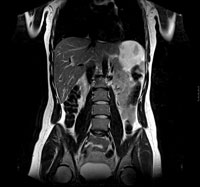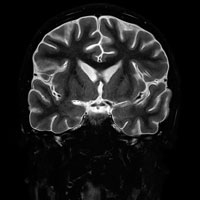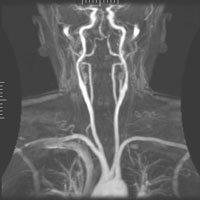- What is an MRI?
- How does MRI work?
- Preparing for an MRI Scan
- During an MRI
- Benefits of MRI
- Risks of MRI
- Limitations of MRI
- After the MRI Scan
- Specialised types of MRI
- Possible findings
What is an MRI?
MRI stands for magnetic resonance imaging, a non-invasive diagnostic technique that uses radio waves rather than x-rays to create images. It is particularly useful for imaging of soft tissues such as the brain, spinal cord, muscles and ligaments and detecting abnormal tissues such as tumours.
How does MRI work?
An MRI scanner is a cylindrical machine, used to get images of the human body. An MRI machine consists of a round tunnel within which the patient lies on a narrow table. Surrounding the tube is a large cylindrical magnet. During an MRI scan, the patient is within a stable magnetic field that is 10,000–30,000 times stronger than the Earth’s magnetic field.
Protons are tiny particles that are present in water molecules throughout the body. These are aligned by the incredibly strong magnetic field, noting that there are no water molecules in the human skeleton, only in bodily tissue. Radio waves are transmitted in pulses, and these protons produce echoes that are emitted out of the body. These echoes are received by the MRI scanner, and are then reconstructed into images of the body by a computer. The images are very precise and give a clear anatomical view of the body from any angle.
Preparing for an MRI scan
The presence of a strong magnetic field means the metal objects of any kind are not permitted within the scanning room during an MRI Scan. All jewellery and clothing containing metal, particularly objects containing iron, need to be removed.
Internal metal objects such as metal clips, medication pumps, or any internal metal items such as shrapnel or metal particles also present a considerable risk and must be made known to the doctor. Other equipment that may cause a risk include cardiac pacemakers or defibrillators, a catheter with metal components, aneurysm clips, and cochlear implants.
Some metal implants do not rule out using an MRI scanner, but some do, and it is important to tell a doctor about any implants or metallic objects.
If a patient suspects they may be pregnant, the doctor must be informed, as little is known about the effect of MRI scans on an unborn baby.
To improve the experience of the MRI, it is advised that the patient not drink for several hours before the scan. This is especially true of coffee and tea, as going to the toilet is not possible without interrupting the scan and beginning again.
During an MRI
Once you are dressed in a medical gown, you will be asked to lie down on a narrow table which will then move into the tunnel.
An MRI can last from 30 minutes to an hour, depending on the scans being performed. The scan consists of sequences, lasting from 2-15 minutes, during which the machine makes knocking noises, which can be loud. Patients are often provided with earphones to listen to music to distract them from these noises during the procedure.
The patient must remain motionless in order to produce a clear picture.
For some patients, claustrophobia may be an issue as the space within the MRI can be confining. Patients with claustrophobic anxiety and children may need light sedation. Throughout the procedure, imaging technicians are able to communicate with the patient via intercom to ensure that the patient is informed and comfortable.
Benefits of MRI
The MRI scan is a painless and safe scan that produces clearer images of the body and its tissues, at any angle. This is particularly useful in detecting soft tissue tumours throughout the body. An MRI is nearly twice as sensitive as x-ray mammography in detecting breast cancer in women with a high genetic risk of the disease. It uses no radiation for scanning and therefore eliminates the health risk of x-rays that do use radiation.
Risks of MRI
While an MRI scan is a relatively safe procedure as there is no damaging radiation involved, there are still several risks.
If the patient is pregnant, or suspects they may be, a doctor should be informed because the effects on an unborn baby are poorly understood.
There is also the risk of patients being injured if they forget to remove pieces of metal from their body or their clothing.
If sedation is required due to claustrophobia, then there are associated risks of over-medication.
If a contrast dye is used, which helps to show up some parts of the body more clearly, there is a small risk of allergic reaction.
Limitations of MRI
An MRI is a very expensive and time consuming investigation compared to other methods such as x-ray and CT. Some parts of the body, like bone, are better examined using simpler techniques such as an x-Ray.
An MRI may not always be able to tell the difference between some disease processes. It is also not a very good investigation for emergencies or accidents because of the long time it takes and the fact that all equipment has to be removed from the room while the machine is running.
After the MRI scan
A radiologist, who is a physician experienced in MRI and other radiology examinations, will analyse the images and send a report with their interpretation to the patient’s personal physician. The patient receives MRI results from the referring physician who ordered the test. The image is available almost immediately, but the time from when the image is made available to when a report is issued will vary depending on the complexity of the case.
Specialized types of MRI
 Magnetic resonance angiography (MRA)
Magnetic resonance angiography (MRA)
This type of MRI is designed to show the blood vessels. It is most often used to examine the arteries and veins of the head, neck, brain and heart.
Usually, a contrast dye that does not leave the blood vessels is injected, so that the vessels show up much brighter than the areas around them. An example of this technique is seen to the right.
Functional MRI
This type of MRI is done on the brain, and not only shows the structure of the brain, but also how much activity is taking place in each part. This has been used to find out what parts of the brain are most active during certain situations or tasks.
Cardiac MRI
This can be used for several different conditions and is dealt with on a separate page.
Possible findings
It is possible that an MRI may show that everything is completely normal; however, there are several things that could be seen on an MRI and this will vary depending on where in the body the scan is being done.
An MRI is very good at showing up problems with soft tissues such as muscles and ligaments. It is the most sensitive investigation for spinal and joint problems. For this reason, MRI is often used in sports-related injuries, allowing the doctor to see even very small tears or areas of swelling and inflammation. Almost all other organs can be examined in some detail using an MRI, showing problems in structure and function.
MRI is most often used to show problems with the soft tissues of the body which can be genetic, or caused by some disease process such as a tumour. This includes areas like the brain, and an MRI can give a particularly clear image of the brain’s structure. This is particularly useful for conditions such as a brain tumor where an MRI is often used to find out exactly where in the brain it is, allowing much more effective surgery.
An MRI is very good at detecting breast cancers in those women with a high genetic predisposition to the disease.
In the abdomen, the MRI is used to look for problems with the liver, pancreas, biliary system and spleen as well as the kidneys and adrenal glands.
Below are two images obtained from an MRI. The image on the left shows the abdomen, showing the liver in the top left of the image, and the back running down the centre. The image on the right shows a healthy brain and shows the high detail available with MRI images.


References
- Chernoff D, Stark P. ‘Principles of Magnetic Resonance Imaging’ [online], UpToDate. Available at URL link (last accessed 13/07/06)
- Hornak JP. The Basics of MRI, 2006 [online]. The Centre for Imaging Science. (Last Accessed 12/07/06) Available from URL link
- Kanal E et al. ACR White Paper on Magnetic Resonance Safety: ACR Magnetic Resonance Safe Practice Guidelines. American College of Radiology, 2004.
- Magnetic Resonance Imaging: Body [online], Radiology Info. Radiological Society of North America, 2006. Available at URL link
- Magnetic Resonance Imaging: Cardiac [online], Radiology Info. Radiological Society of North America, 2006. Available at URL link
- Plevritis SK. Kurian AW. Sigal BM. et al. Cost-effectiveness of screening BRCA1/2 mutation carriers with breast magnetic resonance imaging. JAMA, 2006. 295(20):2374-84.
- Reimer P, Parizel PM, Stichnoth FA (editors). Clinical MR Imaging: a Practical Approach (2nd Edition). Heidelberg, Springer-Verlag, 2003.
- Warner E. Plewes DB. Hill KA. et al. Surveillance of BRCA1 and BRCA2 mutation carriers with magnetic resonance imaging, ultrasound, mammography, and clinical breast examination. JAMA, 2004. 292(11):1317-25.
All content and media on the HealthEngine Blog is created and published online for informational purposes only. It is not intended to be a substitute for professional medical advice and should not be relied on as health or personal advice. Always seek the guidance of your doctor or other qualified health professional with any questions you may have regarding your health or a medical condition. Never disregard the advice of a medical professional, or delay in seeking it because of something you have read on this Website. If you think you may have a medical emergency, call your doctor, go to the nearest hospital emergency department, or call the emergency services immediately.

 Magnetic resonance angiography (MRA)
Magnetic resonance angiography (MRA)





